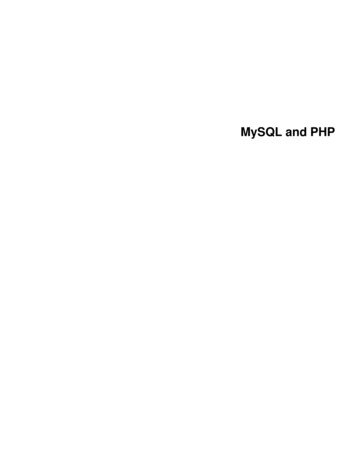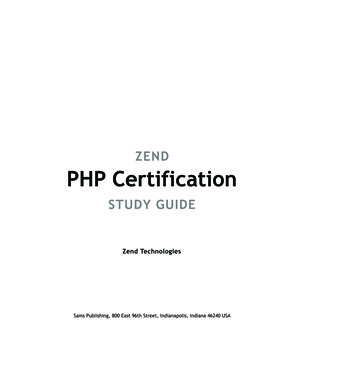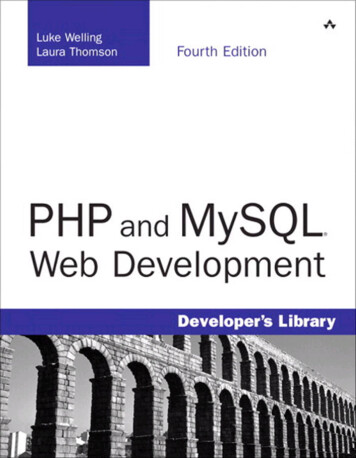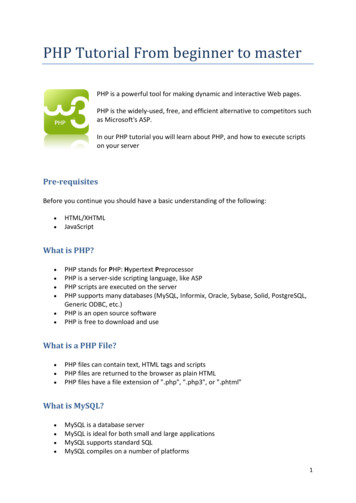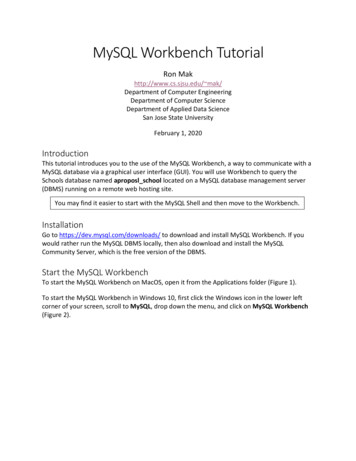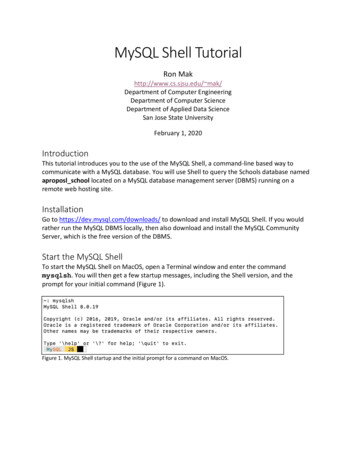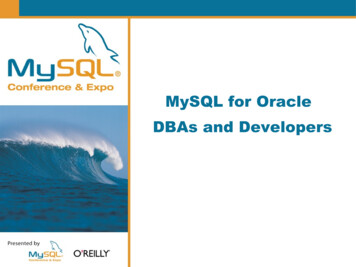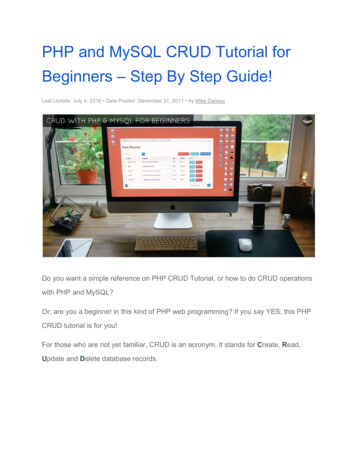
Transcription
PHP and MySQL CRUD Tutorial forBeginners – Step By Step Guide!Last Update: July 4, 2016 Date Posted: December 31, 2011 by Mike DalisayDo you want a simple reference on PHP CRUD Tutorial, or how to do CRUD operationswith PHP and MySQL?Or, are you a beginner in this kind of PHP web programming? If you say YES, this PHPCRUD tutorial is for you!For those who are not yet familiar, CRUD is an acronym. It stands for C reate, R ead,U pdate and D elete database records.
Coding CRUD with PHP and MySQL is one of the basics. PHP web programmers mustbe able to code it with less effort. We can perform this task using any of the three PHPDatabase extensions:1. Using the MySQL extension .2. Using the MySQLi extension .3. Using the PDO extension .PHP 5.5 deprecated the MySQL extension. It is not recommended to use these days.If you are programming with PHP, you’ll have to use either MySQLi (i means improved)or PDO extension.With that in mind, we will use the PDO extension in this simple PHP CRUD tutorial. It isthe most recent way of programming these CRUD operations.We will cover the following topics or contents:1.0 Program Output2.0 File Structure3.0 Prepare The Database3.1 Create the Database3.2 Create the Database Table3.3 Dump Sample Data On The Table3.4 Create Database Connection PHP File4.0 Create Record in PHP4.1 Basic HTML Code For create.php
4.2 HTML Form To Input New Record Data4.3 Code Create A New Record5.0 Read Records in PHP5.1 Basic HTML Code For read.php5.2 Read Records From The Database6.0 Read One Record in PHP6.1 Basic HTML Code For read one.php6.2 Read Records From The Database6.3 Display Record Details7.0 Update Record in PHP7.1 Basic HTML Code For update.php7.2 Read A Record By ID Parameter7.3 HTML Form To Update A Record7.4 Code To Update The Record8.0 Delete Record in PHP8.1 Tell The User If Record Was Deleted8.2 JavaScript To Verify Record Deletion8.3 Delete Record From The Database9.0 Download Source Codes
10.0 Online Resources11.0 What’s Next?12.0 Related Source Codes13.0 Some Notes1.0 PHP CRUD TUTORIAL PROGRAM OUTPUTWe have three LEVELS of source code output. But WHY? Because I believe in"Learning Progression" to ensure efficient learning.Accoding to Dr. W. James Popham , an Emeritus Professor in the UCLA GraduateSchool of Education and Information Studies:"Learning Progression is a sequenced set of skills and knowledge we believe studentsmust learn on the way to mastering a more distant curricular outcome."You can read more about the subject here , here and here .So if you really want to learn, and serious about learning from this programming tutorial:I highly recommend studying the LEVEL 1 source code first, then the LEVEL 2, then theLEVEL 3 source code.1.1 LEVEL 1 Source Code OutputVIDEO: https://www.youtube.com/watch?v YbZOfPqsE70
1.2 LEVEL 2 Source Code OutputVIDEO: https://www.youtube.com/watch?v 0qqs7rH5M7k1.3 LEVEL 3 Source Code OutputYou can see the complete list of features on section 9.0 below.For now, let us continue to learn how the LEVEL 1 source code was made.2.0 PROJECT FILE STRUCTUREOur PHP CRUD tutorial will contain the following main files. dev/ products.sql – contains the database table structure and sample dataused in this project. Once you created your database in PhpMyAdmin, youcan import this file.
libs/ – is where our Bootstrap CSS framework and jQuery library is located. config/ database.php – used for database connection and configuration. create.php – used for creating a new record. It contains an HTML form wherethe user can enter details for a new record. read.php – used for reading records from the database. It uses an HTMLtable to display the data retrieved from the MySQL database. read one.php – used for reading one or single record from database. It usesan HTML table to display the data retrieved from the MySQL database. update.php – used for updating a record. It uses an HTML form which will befilled out with data based on the given “id” parameter. delete.php – used for deleting a record. It accepts an “id” parameter anddeletes the record with it. Once it execute the delete query, it will redirect theuser to the read.php page.3.0 PREPARE THE DATABASE3.1 Create the DatabaseOn your PhpMyAdmin, create a database named “1phpbeginnercrudlevel1”.If you’re not sure how to do it, please take a look at the following example. Follow onlythe “create database” part.VIDEO: https://www.youtube.com/watch?v ULMwIO3Gt03.2 Create the Database TableNext, run the following SQL code. This is to create our “products” database table. Ifyou’re not sure how to do this, take a look at this resource .
Table structure for table products CREATE TABLE IF NOT EXISTS products ( id int(11) NOT NULL AUTO INCREMENT, name varchar(128) NOT NULL, description text NOT NULL, price double NOT NULL, created datetime NOT NULL, modified timestamp NOT NULL DEFAULT CURRENT TIMESTAMP ON UPDATECURRENT TIMESTAMP,PRIMARY KEY ( id )) ENGINE InnoDB DEFAULT CHARSET latin1 AUTO INCREMENT 9 ;3.3 Dump Sample Data On The TableAgain, run the following SQL code on your PhpMyAdmin. This will insert the sampledata or record on our ‘products’ database table. Dumping data for table products INSERT INTO products ( id , name , description , price , created , modified ) VALUES(1, 'Basketball', 'A ball used in the NBA.', 49.99, '2015 08 0212:04:03', '2015 08 06 06:59:18'),
(3, 'Gatorade', 'This is a very good drink for athletes.', 1.99,'2015 08 02 12:14:29', '2015 08 06 06:59:18'),(4, 'Eye Glasses', 'It will make you read better.', 6, '2015 08 0212:15:04', '2015 08 06 06:59:18'),(5, 'Trash Can', 'It will help you maintain cleanliness.', 3.95,'2015 08 02 12:16:08', '2015 08 06 06:59:18'),(6, 'Mouse', 'Very useful if you love your computer.', 11.35,'2015 08 02 12:17:58', '2015 08 06 06:59:18'),(7, 'Earphone', 'You need this one if you love music.', 7,'2015 08 02 12:18:21', '2015 08 06 06:59:18'),(8, 'Pillow', 'Sleeping well is important.', 8.99, '2015 08 0212:18:56', '2015 08 06 06:59:18');As you may have noticed, steps 1 and 2 are both SQL queries. Yes, they can run at thesame time. But I wanted it to be on separate steps to emphasize those SQL queries’purpose.3.4 Create Database Connection PHP FileCreate database.php file and put the following code inside it. It answers the question:how to connect to MySQL database with PDO? ?php// used to connect to the database host "localhost"; db name "1phpbeginnercrudlevel1"; username "root"; password "";
try { con new PDO("mysql:host { host};dbname { db name}", username, password);}// show errorcatch(PDOException exception){echo "Connection error: " . exception getMessage();}? 4.0 CREATE RECORD IN PHP4.1 Basic HTML Code For create.phpCreate the create.php file. We will use it to create a new record to the database. Put thecode following code inside the create.php file.We use Bootstrap user interface for this project. Make sure you downloaded a copy andput it inside the “libs” folder.If you are not familiar with Bootstrap, please learn our Bootstrap Tutorial for Beginnersreal quick. !DOCTYPE HTML html head title PDO Create a Record PHP CRUD Tutorial /title
! Bootstrap ! Latest compiled and minified CSS link rel "stylesheet"href "libs/bootstrap 3.3.6/css/bootstrap.min.css" / ! HTML5 Shiv and Respond.js IE8 support of HTML5 elements andmedia queries ! WARNING: Respond.js doesn't work if you view the page viafile:// ! [if lt IE 9] scriptsrc " hiv.js " /script scriptsrc " nd.min.js " /script ![endif] /head body ! container div class "container" div class "page header" h1 Create Product /h1 /div
! dynamic content will be here /div ! end .container ! jQuery (necessary for Bootstrap's JavaScript plugins) script src "libs/jquery 3.0.0.min.js" /script ! Include all compiled plugins (below), or include individualfiles as needed script src "libs/bootstrap 3.3.6/js/bootstrap.min.js" /script /body /html 4.2 HTML Form To Input New Record DataNow we are going to start answering the question: how to create a record with PDO?The code below will create an HTML form with input fields that matches the fields in thedatabase. Put it inside the “container” div of create.php of section 4.1 above. ! html form here where the product information will be entered form action 'create.php' method 'post' table class 'table table hover table responsive table bordered' tr td Name /td td input type 'text' name 'name' class 'form control'/ /td /tr
tr td Description /td td textarea name 'description'class 'form control' /textarea /td /tr tr td Price /td td input type 'text' name 'price' class 'form control'/ /td /tr tr td /td td input type 'submit' value 'Save' class 'btnbtn primary' / a href 'read.php' class 'btn btn danger' Back toread products /a /td /tr /table /form 4.3 Code To Create A New RecordWe are still working in the create.php file. Once the user filled out the form and clickedthe save button in section 4.2, the code below will save it to the MySQL database. Put itabove the “form” tag of section 4.2 above. ?php
if( POST){// include database connectioninclude 'config/database.php';try{// insert query query "INSERT INTO products SET name :name,description :description, price :price, created :created";// prepare query for execution stmt con prepare( query);// posted values name htmlspecialchars(strip tags( POST['name'])); description htmlspecialchars(strip tags( POST['description'])); price htmlspecialchars(strip tags( POST['price']));// bind the parameters stmt bindParam(':name', name); stmt bindParam(':description', description); stmt bindParam(':price', price);// specify when this record was inserted to the database created date('Y m d H:i:s');
stmt bindParam(':created', created);// Execute the queryif( stmt execute()){echo " div class 'alert alert success' Record wassaved. /div ";}else{echo " div class 'alert alert danger' Unable to saverecord. /div ";}}// show errorcatch(PDOException exception){die('ERROR: ' . exception getMessage());}}? 5.0 READ RECORDS IN PHP5.1 Basic HTML Code For read.phpCreate the read.php file. We prepare this to read records from the database. It answersthe question: how to read records with PDO?Put the following code inside the read.php file.
!DOCTYPE HTML html head title PDO Read Records PHP CRUD Tutorial /title ! Bootstrap ! Latest compiled and minified CSS link rel "stylesheet"href "libs/bootstrap 3.3.6/css/bootstrap.min.css" / ! HTML5 Shiv and Respond.js IE8 support of HTML5 elements andmedia queries ! WARNING: Respond.js doesn't work if you view the page viafile:// ! [if lt IE 9] scriptsrc " hiv.js " /script scriptsrc " nd.min.js " /script ![endif] ! custom css style .m r 1em{ margin right:1em; }.m b 1em{ margin bottom:1em; }
.m l 1em{ margin left:1em; } /style /head body ! container div class "container" div class "page header" h1 Read Products /h1 /div ! dynamic content will be here /div ! end .container ! jQuery (necessary for Bootstrap's JavaScript plugins) script src "libs/jquery 3.0.0.min.js" /script ! Include all compiled plugins (below), or include individualfiles as needed script src "libs/bootstrap 3.3.6/js/bootstrap.min.js" /script /body /html
5.2 Read Records From The DatabaseThis time we will read records from the database. Put the following code inside the“container” div tags in section 5.1 above. ?php// include database connectioninclude 'config/database.php';// select all data query "SELECT id, name, description, price FROM products ORDER BYid DESC"; stmt con prepare( query); stmt execute();// this is how to get number of rows returned num stmt rowCount();// link to create record formecho " a href 'create.php' class 'btn btn primary m b 1em' Create NewProduct /a ";//check if more than 0 record foundif( num 0){echo " table class 'table table hover table responsivetable bordered' ";//start table
//creating our table headingecho " tr ";echo " th ID /th ";echo " th Name /th ";echo " th Description /th ";echo " th Price /th ";echo " th Action /th ";echo " /tr ";// retrieve our table contents// fetch() is faster than 0630/pdofetchall vs pdofetch in a loopwhile ( row stmt fetch(PDO::FETCH ASSOC)){// extract row// this will make row['firstname'] to// just firstname onlyextract( row);// creating new table row per recordecho " tr ";echo " td { id} /td ";echo " td { name} /td ";echo " td { description} /td ";echo " td ${ price} /td ";echo " td ";
// read one recordecho " a href 'read one.php?id { id}' class 'btnbtn info m r 1em' Read /a ";// we will use this links on next part of thispostecho " a href 'update.php?id { id}' class 'btnbtn primary m r 1em' Edit /a ";// we will use this links on next part of thispostecho " a href '#' onclick 'delete user({ id});'class 'btn btn danger' Delete /a ";echo " /td ";echo " /tr ";}// end tableecho " /table ";}// if no records foundelse{echo " div No records found. /div ";}?
The code above shows: The inclusion of database.php file from section 3.4 The SELECT SQL query. The HTML table where the retrieved data will be put.6.0 READ ONE RECORD IN PHP6.1 Basic HTML Code For read one.phpCreate a PHP file and name it read one.php – this is where we will read and display thedetails of a single database record. Put the following basic HTML code. !DOCTYPE HTML html head title PDO Read One Record PHP CRUD Tutorial /title ! Bootstrap ! Latest compiled and minified CSS link rel "styleshee
PHP and MySQL CRUD Tutorial for Beginners – Step By Step Guide! Last Update: July 4, 2016 Date Posted: December 31, 2011 by Mike Dalisay Do you want a simple reference on PHP CRUD Tutorial, or how to do CRUD operations with PHP and MySQL?
